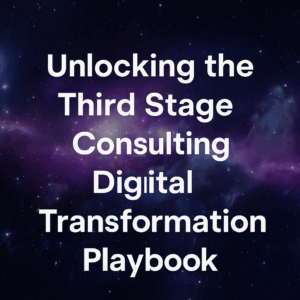When digital transformations do not go well, the cost after implementation can be exponentially higher than the initial cost of the transformation itself. However, why does this happen, and what should we be aware of?

When undergoing digital transformations with our clients, they often struggle with a decision regarding how to optimize implementation time, cost, and risk. However, this focus on time, cost, and risk does not always consider the potential cost, risk, and time associated with disruption if the digital transformation goes poorly. To provide some context, our research indicates that between 52% and 54% of organizations experience significant operational disruptions when they go live with new technology.
By “material operational disruption,” I mean more than just the usual challenges and learning curve issues. I am referring to major problems such as the inability to ship products, run payroll, or close the books—issues that bring an organization to a halt and render it inoperational for a certain period. Therefore, today I would like to discuss the cost of disruption if we do not execute our digital transformation correctly or if we cut corners regarding timing and costs during the process. What are the long-term impacts and costs?
In this discussion, I will explore the factors to consider as you navigate the short-term timing and costs associated with digital transformation, in relation to the potential negative impacts and costs that may arise afterward.
Table of Contents
ToggleInitial Time and Cost
Let’s begin by addressing what most organizations tend to focus on, which is the initial short-term implementation time and cost. Often, organizations become fixated on how long a project will take and what the budget will be. Limited resources and time constraints contribute to this need for optimizing time and cost. It’s understandable why humans and organizations would prioritize these factors. However, it is uncommon for organizations to consider the long-term implications of these short-term timing and cost decisions.
For instance, organizations could potentially reduce time and cost in the initial implementation by cutting back on elements such as organizational change, employee training, or iterations of user acceptance testing. There are numerous ways to scale back implementation time and cost. In fact, I would argue that technology could be implemented in half the time and budget currently planned. However, the crucial question to ponder is whether this approach is advisable or if it will lead to favorable outcomes during implementation.
While I have provided extreme examples of elements you wouldn’t want to cut back on, it surprises me how many organizations and their teams unintentionally make such trade-offs without considering the long-term implications in terms of time, cost, and risk. It is essential to control time and cost to mitigate risks during implementation. However, it is equally important to assess the long-term implications.
Cost of Go-Live and Operational Disruption
Now, the aspect that may not be immediately evident to organizations is the need to truly understand, quantify, and mitigate the costs and risks associated with going live and the post-go-live phase. Specifically, it is crucial to comprehend the cost of disruptions if things do not go well or if significant operational disruptions occur when implementing new technologies. What would be the financial impact on the organization if, for instance, product shipments were halted for two weeks? What would it cost if payroll processing couldn’t be conducted for a week or two, or if it had to be done manually? Similarly, if the organization couldn’t close its books or provide executives with financial visibility for two or three months, what would be the consequences?
These are essential considerations, not intended to instill fear, but rather to comprehend the associated costs. By doing so, organizations can avoid solely focusing on short-term implementation costs and instead strike a balance between the two aspects. Implementing things correctly may increase the initial implementation timing cost, but it can and should mitigate long-term risks and costs. Of course, the opposite scenario is also possible. Excessive time spent on implementation without effectively mitigating long-term risks would not be desirable.
The key lies in recognizing the interconnection between implementation actions and their impact on long-term digital and operational disruptions, along with the costs involved. Allow me to share a brief example or case study from early in my career. One of the first projects I managed at my previous company involved assisting a mid-size manufacturing organization in implementing a manufacturing ERP system. The project lasted around 16 to 18 months, experiencing a couple of delays due to numerous software customizations requested by the customer. These customizations extended the timeline.
After the two delays, a go/no-go decision was imminent. Our recommendation was that they were still not ready for go-live and should extend the go-live date by approximately 30 days. However, this extension would have incurred an additional cost of nearly $100,000 for the organization. While not an insignificant sum, it may not be exorbitant for most organizations either. Ultimately, the CEO decided to proceed without the extension, forgoing the additional 30 days and the extra budget.
A few weeks after the go-live, it became apparent that many aspects of the technology were not functioning properly, particularly the product configurator used to determine how a make-to-order engineering or manufacturing firm assembles its products. The business rules behind the configurator were flawed, resulting in the inability to ship products to several customers. This led to over $10 million in lost sales, equating to a net profit loss of over $1 million. While they saved $100,000 during the implementation phase, it ended up costing them over a million dollars in lost orders.
This example highlights the importance of optimizing and understanding the long-term costs as well as the short-term ones. It illustrates why it is crucial to navigate both sides of the equation, ensuring effective decision-making and risk mitigation.

Long Term Business Value
So far, we have been discussing the essential aspects of ensuring implementation close to the designated timeline and budget, as well as avoiding operational disruptions. However, the true value and return on investment (ROI) lie not only in achieving implementation success and operational stability but also in deriving business value from the transformation. In other words, it’s essential to go on the offense rather than solely playing defense and aiming to avoid negative outcomes or potential job termination due to project failures. The goal should be to deliver measurable ROI and tangible improvements for the organization compared to its pre-transformation state.
To accomplish this, it is crucial to set a business case that defines the measures, expectations, and potential business value. Doing so provides a guiding light or North Star, aiding in making well-informed decisions throughout the implementation process. For instance, when a project team member proposes adding a new module or customizing the software, it is important to assess whether it aligns with tangible, measurable business value. If not, it’s likely not worth pursuing. This approach serves as an effective governance tool to maintain focus and ensure success by prioritizing the delivery of business value.
It is essential not to lose sight of long-term business value as you progress through the digital transformation project. This value should remain at the forefront of decision-making and project execution.
How To Optimize Short and Long Term Cost
The key takeaway here is that achieving a successful digital transformation involves striking a delicate balance. You should aim to optimize short-term implementation time, cost, and risk, minimize long-term operational disruptions, and maximize long-term business value. While it may sound straightforward, it is a complex task. That’s why developing a solid business case and making decisions based on measurable performance indicators and risk management are crucial. It’s important to recognize that any decision to increase or decrease the implementation budget will merely shift the risk within the equation. Finding the right balance requires a combination of art and science, and experienced assistance from organizations and consultants like Third Stage Consulting can be invaluable in making decisions that align with your specific needs. I hope this guidance has provided you with some valuable insights to consider, both in terms of short-term implementation considerations and long-term success.

I would enjoy brainstorming ideas with you if you are looking to strategize an upcoming transformation or are looking at selecting an ERP system, so please feel free to contact me at eric.kimberling@thirdstage-consulting.com. I am happy to be a sounding board as you continue your digital transformation journey.





